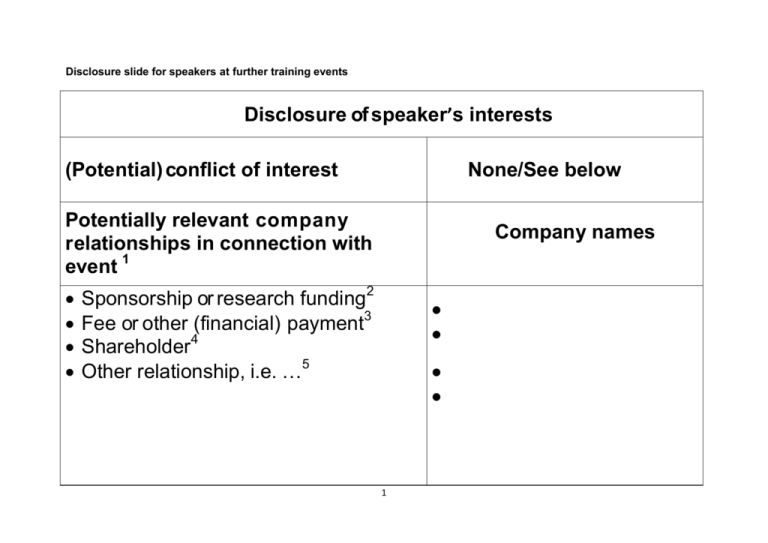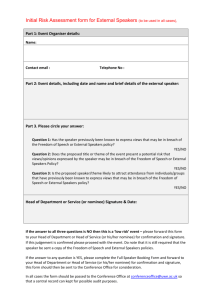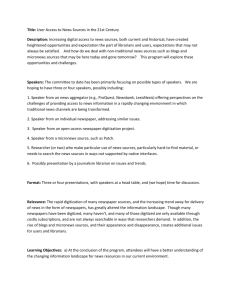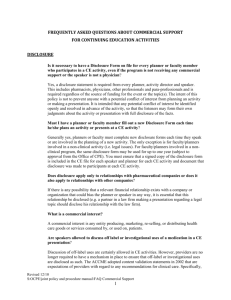Disclosure slide for speakers at further training events
advertisement

Disclosure slide for speakers at further training events Disclosure of speaker’s interests (Potential) conflict of interest None/See below Potentially relevant company relationships in connection with event 1 Company names Sponsorship or research funding2 Fee or other (financial) payment3 Shareholder4 Other relationship, i.e. …5 1 Explanation Under the rules on the advertising of medicinal products (Dutch Medicines Act: Inducement Policy Guidelines and the CGR Code of Conduct) a speaker at a further training event must be transparent about his/her interests in industry. In its study of the level of compliance with the advertising rules in the further training of medical specialists (November 2012), the Health Care Inspectorate found that speakers are failing to comply sufficiently with the obligation to publicise ties with industry before the presentation. The Health Care Inspectorate has announced that it is going to actively supervise the publication of ties between speakers and industry. To help speakers who speak at a further training event comply with the obligation to make ties transparent, the KNMG and the CGR have developed this format for a disclosure sheet in coordination with the Health Care Inspectorate. The format is in line with current obligations regarding the publication of (financial) ties with industry, such as the KNAW/KNMG code for the prevention of bias through conflict of interest (hereinafter KNAW Code of Interests), the transparency rules of CGR Code of Conduct (chapter 7) and the publication of clinical studies in the Dutch trial register. The format developed by the European Union of Medical Specialists (UEMS) has also been looked at. Speakers are expected to show the disclosure sheet before they start with the substantive presentation. The public should be enabled to take notice of the disclosure sheet. The disclosure sheet will be included in hand outs of the presentations. The disclosure sheet is also used for the accreditation of trainings. An explanation of the different fields of the disclosure sheet is given below. 1. Potentially relevant company relationships in connection with event This about relationships with industry, i.e. the pharmaceutical industry, the biotechnology industry, the medical devices industry and the medical food industry. These are the relationships that are considered relevant for registration in the Dutch Trial Register. This does not apply to subsidies from the government of non-governmental organisations. 2. Sponsorship or research funding The KNAW Interests Code states the following: “Externally funded research may give rise to a conflict of interest. In many fields there are no or scarcely any public funds available (such as funding by universities or NWO) and research is only possible in the form of contract research, where the research is funded by government or industry and the research subject is usually very carefully defined. The initiative for contract research can come from either a university or a financier, but the universities guarantee 2 independent performance (including freedom of publication for the researchers and full accountability of the funding sources). Universities have developed standard contracts for research of this kind and the KNAW has drawn up a code of conduct (set out in its ‘Science to order’ advice from 2005). Nevertheless, such a relationship may induce a scientist to be more receptive to the interests of the financier of the research. It is therefore important to guard against the risk of this form of dependence making a scientist susceptible to a conflict of interest.” If the speaker has been (or still is) involved in research or a project that has been funded by industry, he/she will be expected to report this on the disclosure sheet. This concerns sums exceeding €500 (cumulative per year) made in the last four years. It is usually data that is published through the Dutch Trial Register or the central Transparency Register. 3. Fee or other (financial) payment The KNAW Interests Code states the following: “Personal financial interests are the most obvious cause of conflict of interest. Examples include a member of an advisory committee employed by a company operating in the area to which the advice relates […]. It is also imaginable that an expert has a personal financial interest in the form of consultancy work in the business community or with a pressure group.” If the speaker (on the basis for example of a contract of engagement or in employment) performs or has performed services for a company, he/she must say so where the remuneration represents a value in excess of €500 (cumulative per year) and the services in question have taken place within a period of four years prior to the date of the presentation. It may for example be a matter of consultancy services (as on an advisory committee of the company), the writing of an article on instructions or the holding of a presentation. It is not crucial for the speaker to be the beneficiary of the remuneration him/herself. The relationship must also be reported if the remuneration has not been made directly to the speaker, but has been granted to another legal entity (such as a work practice of the speaker, a (research) foundation, a care institution/hospital or an organisation or speakers’ agency). The data concerned will generally be included in the Transparency Register. 4. Shareholder The ownership of shares or options in a company may indicate a personal financial interest that may be a cause of conflict of interest. There must be openness about this. 3 In this regard it must be a matter of a substantial interest in a company, which exists if the speaker concerned has 5% or more of the shares in the company (including the shares of his/her partner). This also applies if the speaker has this interest through another legal entity. 5. Other relationship, i.e. … Other relationships may also exist that might lead to a form of a conflict of interest, such as personal relations with persons from the immediate vicinity (for example the partner and/or children) who may benefit from a particular presentation of things that the speaker will present. The speaker will be expected to indicate this on the disclosure sheet. 4








